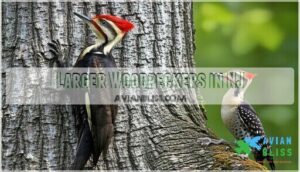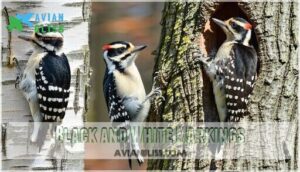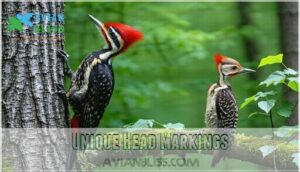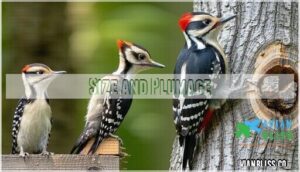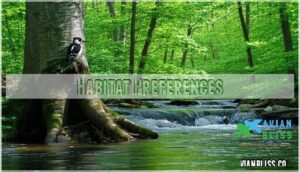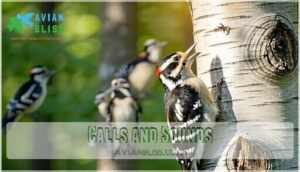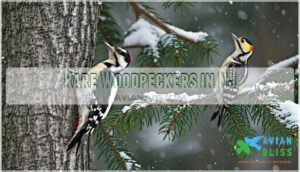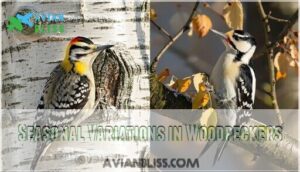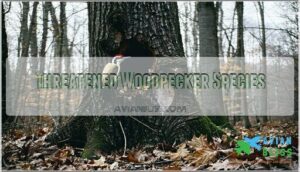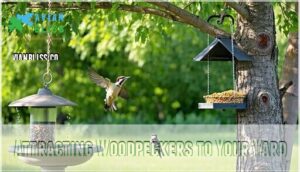This site is supported by our readers. We may earn a commission, at no cost to you, if you purchase through links.
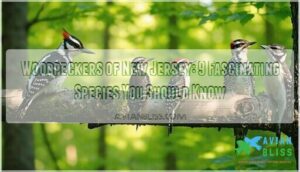
The tiny Downy Woodpecker, smaller than your phone, shares territory with the crow-sized Pileated Woodpecker that sounds like nature’s jackhammer.
Common species include the zebra-striped Hairy Woodpecker and ground-foraging Northern Flicker, while Red-bellied Woodpekers bring tropical flair to suburban feeders.
Rarer gems like the Red-headed Woodpecker and Yellow-bellied Sapsucker require sharper eyes to spot.
Each species has carved out its own unique niche, from bark-gleaning techniques to preferred tree types.
Knowing their unique calls, markings, and feeding habits transforms any backyard into a birding hotspot.
Table Of Contents
- Key Takeaways
- Common Woodpeckers in NJ
- Larger Woodpeckers in NJ
- Woodpeckers With Distinctive Markings
- Woodpecker Identification Guide
- Rare Woodpeckers in NJ
- Seasonal Variations in Woodpeckers
- Threatened Woodpecker Species
- Woodpecker Conservation Efforts
- Attracting Woodpeckers to Your Yard
- Frequently Asked Questions (FAQs)
- What is the largest woodpecker in New Jersey?
- Is it good to have woodpeckers in your yard?
- What bird looks like a woodpecker but isn’t?
- What does it mean when you see a woodpecker is pecking a tree?
- What is the largest woodpecker in NJ?
- What is the difference between a woodpecker and a sapsucker?
- Are woodpeckers common in NJ?
- What woodpecker has a red head in NJ?
- How do woodpeckers avoid brain damage from pecking?
- What role do woodpeckers play in forest ecosystems?
- Conclusion
Key Takeaways
- You’ll find nine distinct woodpecker species in New Jersey year-round, ranging from the tiny Downy Woodpecker to the massive crow-sized Pileated Woodpecker, each with unique markings and behaviors that make identification easier once you know what to look for.
- You can attract these birds to your backyard by setting up suet feeders with high-fat blends, preserving dead trees for nesting sites, and planting native hardwoods like oak and maple that attract the insects woodpeckers feed on.
- You’ll spot common species like Downy, Hairy, Northern Flicker, and Red-bellied Woodpeckers throughout the year, while rarer visitors like Yellow-bellied Sapsuckers only appear in winter and Red-headed Woodpeckers require sharper eyes due to declining populations.
- You can identify different species by focusing on their size, distinctive head markings, unique calls and drumming patterns, and preferred habitats—from dense forests to suburban backyards, including native hardwoods and dead trees for nesting sites, which help in identifying distinct woodpecker species.
Common Woodpeckers in NJ
You’ve probably seen several woodpecker species in New Jersey’s forests or even your backyard.
Common ones like the Downy, Hairy, Northern Flicker, and Red-bellied Woodpecker are active all year, each with unique traits making them easy to spot.
Downy Woodpecker
The Downy Woodpecker, New Jersey’s smallest woodpecker, thrives in urban habitats and forests alike.
You’ll often see these adaptable diners pecking tree trunks or enjoying suet feeders in backyards. They’re easy to spot with their black-and-white markings.
Males sport a red patch—useful for identifying females. Listen for their sharp "pik" calls and watch them bring life to the trees with determined, rhythmic taps.
- Thrives in diverse habitats
- Dines on insects and suet feeders
- Distinguishes males by red head patch
- Known for high-pitched "pik" calls
- Common backyard visitor
Hairy Woodpecker
The Hairy Woodpecker, a standout among New Jersey woodpeckers, thrives in forests and urban areas alike.
Its bold black-and-white plumage and sharp, chisel-like beak make woodpecker identification in NJ easier. Look for them pecking dead trees for insects or hear their distinctive calls.
Protecting their habitat guarantees these common woodpeckers in NJ continue their important ecological role.
| Feature | Description | Fun Fact |
|---|---|---|
| Size | 7-10 inches | Larger than the Downy Woodpecker |
| Plumage | Black and white | Males sport a red head patch |
| Diet | Insects, seeds | Loves carpenter ants |
| Habitat | Forests, urban areas | Prefers areas with dead trees |
| Call | High-pitched, sharp | Sounds like a squeaky toy |
Northern Flicker
The Northern Flicker, one of the most common woodpeckers in NJ, stands out with its striking features:
- Black bib and spotted belly
- Red nape patch and yellow underwings
- Ground-foraging behavior for ants and beetles
Known for its loud, rhythmic calls, this bird prefers open woodlands and even backyards.
Spotting one adds excitement to any New Jersey birdwatching adventure!
Red-bellied Woodpecker
The red-bellied woodpecker, a favorite among backyard woodpeckers in NJ, is easy to spot with its barred back and pale red belly.
Males boast red plumage from crown to nape, while females only show red on their necks.
Known for their rolling vocalizations, these common woodpeckers in NJ forage insects and fruits, showcasing fascinating dietary habits and nesting behavior.
Larger Woodpeckers in NJ
New Jersey boasts two impressive larger woodpecker species:
- Pileated Woodpecker NJ: This crow-sized bird, with its bold red crest and striking black-and-white face stripes, thrives in mature forests.
- Northern Flicker: Unlike most woodpeckers, Flicker diet includes ants and beetles from the ground.
Its spotted breast and white rump make it easy for woodpecker identification NJ enthusiasts.
Known for their rectangular holes, their nesting habits and Pileated behavior are fascinating to watch.
Both species face habitat loss, highlighting the need for conservation efforts to protect these woodpecker species in New Jersey.
These woodpeckers play a vital role in cavity creation for wildlife, offering shelter to other species.
Woodpeckers With Distinctive Markings
You’ll recognize many woodpeckers in New Jersey by their striking markings, from bold red crests to intricate black-and-white patterns.
These features both make them stand out and help you identify different species with ease.
Red Markings
Ever noticed a splash of red darting through the trees? That’s your cue to jump into woodpecker identification in NJ!
The redheaded woodpecker steals the show with its vivid red head and neck, while the male pileated woodpecker flaunts a dramatic red crest. Look for red cheek stripes on males of the hairy woodpecker NJ species or the subtle red crescent on a northern flicker’s nape.
These bold head patterns and plumage variations make spotting and identifying males a colorful adventure in your backyard. Some species, like the Northern Cardinal, are backyard royalty with brilliant scarlet plumage, showcasing their unique features as backyard royalty with a notable red head.
Black and White Markings
The black and white plumage patterns of common woodpeckers in NJ, like these three, are mesmerizing:
- Downy Woodpecker: Tiny with white-spotted backs and contrasting colors.
- Hairy Woodpecker: Larger, with bold black-and-white barred feathers.
- Red-cockaded Woodpecker: Rare, with subtle spotting variations.
These markings aren’t just pretty—they help these backyard woodpeckers blend into New Jersey’s trees flawlessly!
Unique Head Markings
How do you spot woodpecker species in New Jersey? Look closely at their head markings!
The Pileated Woodpecker’s bold red crest variations are striking, while the Red-headed Woodpecker boasts vibrant crown coloration.
Northern Flickers add charm with facial stripe differences resembling whiskers. Males and females often differ, like in their head spot patterns.
Mastering woodpecker identification through these markings makes bird plumage observation both fun and rewarding!
Woodpecker Identification Guide
You can identify New Jersey’s woodpeckers by focusing on their size, plumage, and unique markings.
Pay attention to their habitats and calls, as these clues often make spotting the right species much easier, focusing on complete concepts.
Size and Plumage
When spotting woodpeckers in New Jersey, their plumage variation and size differences make identification fun.
From the tiny Downy to the towering Pileated, their bird coloration ranges from bold red crests to subtle black-and-white patterns.
Look for sexual dimorphism—males often sport brighter markings.
Juveniles may show aberrant coloration, adding to the challenge of identifying these fascinating feathered carpenters.
Accurate identification requires understanding specific plumage features.
Habitat Preferences
Woodpecker habitats in New Jersey vary widely, from dense forests to suburban backyards.
Many species rely on deadwood in mature forests for nesting sites, while others adapt to urban areas with surprising ease.
Riparian habitats near rivers also attract these birds due to abundant food.
Protecting diverse forest compositions guarantees these adaptable New Jersey birds continue thriving despite habitat changes and climate challenges.
Calls and Sounds
Walking through New Jersey’s forests, you’ll likely hear woodpecker sounds NJ—each species has its own acoustic communication style.
Their drumming patterns and vocalizations aren’t just noise; they’re nature’s Morse code. From the Downy’s rapid taps to the Northern Flicker’s sharp “wicka-wicka,” these bird calls reveal their roles in the ecosystem.
- Drumming Patterns: Used for territory marking.
- Vocalizations: Mating calls or warnings.
- Sound Identification: Helps distinguish species.
- Call Meanings: Signals intentions.
- Bird Species Calls: Reflect unique behaviors.
Rare Woodpeckers in NJ
You might be surprised to learn that New Jersey occasionally hosts some rare woodpecker species.
These include the elusive Black-backed and American Three-toed Woodpeckers, which are typically found in northern coniferous forests.
Yellow-bellied Sapsucker
The yellow-bellied sapsucker, a standout among woodpecker species in New Jersey, is known for its sap-feeding habits.
These migratory birds create neat rows of sap wells in tree bark, benefiting other wildlife.
- Identifying Sapsuckers: Look for a mottled black-and-white back and yellowish belly.
- Sapsucker Migration: Winter visitors to NJ.
- Sapsucker Damage: Harmless but noticeable tree scars.
Red-headed Woodpecker
The Red-headed Woodpecker stands out with its crimson head and bold black-and-white body.
Habitat loss and population decline make this woodpecker species in New Jersey rare. They love suet, peanuts, and nesting in dead timber. Supporting conservation can help protect their dwindling numbers.
Some birds, like the Acorn Woodpecker, store food in granaries.
Diet
Habitat
Plumage
Behavior
Call
Black-backed Woodpecker
Among New Jersey’s rarest woodpecker species, the Black-backed Woodpecker stands out with its distinctive three-toed feet and fire-following behavior.
This medium-sized bird thrives in post-fire ecology, making New Jersey sightings exceptionally uncommon due to habitat loss.
Here’s what makes this species remarkable:
- Forest Fires create ideal feeding grounds with abundant insect infestation
- Conservation Status remains stable despite limited northeastern range
- Habitat Loss threatens available coniferous forests in New Jersey
- Post-fire Ecology specialist, arriving weeks after burns
- Blackbacked Woodpecker populations shift with burning cycles
American Three-toed Woodpecker
You’ll rarely spot the American Three-toed Woodpecker in New Jersey due to habitat loss and its specialized northern range.
This elusive rare bird species faces significant identification challenges among New Jersey wildlife enthusiasts.
Key features include:
- Medium-sized with distinctive three-toed feet
- Males display yellow crown patches
- Black and white barred plumage
- Prefers dying coniferous trees
- Conservation status remains uncertain despite range expansion concerns, affecting its conservation status and habitat loss.
Seasonal Variations in Woodpeckers
You’ll notice that woodpecker activity in New Jersey changes dramatically throughout the year, with some species like the Yellow-bellied Sapsucker arriving only in winter while others become more active during spring breeding season.
Most of New Jersey’s seven woodpecker species stay year-round, but their behaviors shift from territorial drumming and nest-building in spring to quieter foraging patterns in fall and winter, which is a significant change in their annual activity patterns.
Breeding Season
During spring’s arrival, New Jersey’s woodpeckers transform into master builders and devoted parents.
You’ll witness fascinating nesting behavior as males drum loudly to claim territories and attract mates. These bird nesting experts excavate fresh cavities in dead trees, with egg laying typically occurring in April through June.
Parental care involves both sexes incubating eggs for two weeks, then feeding insects to hungry chicks. Chick development progresses rapidly, and fledgling success depends on abundant food sources.
During this time, woodpeckers exhibit heightened territorial behavior, defending their nesting sites. This breeding season showcases why woodpecker species thrive across New Jersey’s diverse forests.
Winter Visitors
Winter transforms New Jersey’s woodpecker landscape as migration patterns bring fascinating seasonal visitors.
Winter brings fascinating feathered visitors to transform New Jersey’s woodpecker community with seasonal magic.
The Yellow-bellied Sapsucker becomes your most reliable winter guest, arriving from northern breeding grounds with remarkable cold adaptations. Their winter diet shifts from tree sap to insects and berries, demonstrating impressive Sapsucker behavior flexibility.
You’ll spot these winter woodpecker species New Jersey offers:
- Yellow-bellied Sapsuckers drilling neat rows of holes in maple and birch trees
- Increased Red-bellied Woodpecker activity at suet feeders during harsh weather
- Northern Flickers gathering in mixed flocks, enhancing your woodpecker birding NJ experience
Habitat availability determines bird migration success throughout winter months.
Threatened Woodpecker Species
New Jersey’s woodpecker species face serious threats from habitat loss and climate change.
The Red-headed Woodpecker’s conservation status changed to threatened in 1979 due to population decline.
Meanwhile, the Red-cockaded Woodpecker was completely extirpated from the state.
Invasive species and disappearing deadwood forests continue threatening these endangered species, making avian conservation efforts absolutely critical for woodpecker species New Jersey residents once enjoyed.
Woodpecker Conservation Efforts
Protecting woodpecker populations requires dedicated bird conservation efforts across New Jersey.
These avian conservation programs focus on three key areas:
- Habitat Preservation through sustainable Forest Management and protected nesting sites
- Nesting Protection by maintaining dead trees and creating artificial cavities
- Insecticide Reduction to preserve their food sources
Public Awareness campaigns help residents understand how woodpecker conservation benefits our entire ecosystem.
Attracting Woodpeckers to Your Yard
You can easily transform your backyard into a woodpecker haven by providing the right food sources and habitat features that these remarkable birds need to thrive.
Setting up suet feeders filled with high-energy fat mixtures and creating dead wood areas will attract New Jersey’s seven woodpecker species, from tiny Downy Woodpeckers to impressive Pileated Woodpeckers.
Suet and Bird Feeders
Setting up the right bird feeders can turn your backyard into a woodpecker paradise. Different New Jersey woodpeckers have distinct preferences for suet types and feeder placement.
| Woodpecker Species | Preferred Food | Feeder Type |
|---|---|---|
| Downy Woodpecker | Plain suet, sunflower seeds | Cage feeders |
| Hairy Woodpecker | High-fat suet blends | Upside-down feeders |
| Northern Flicker | Peanuts, corn suet | Ground feeders |
| Red-bellied Woodpecker | Fruit suet, nuts | Pole-mounted feeders |
| Pileated Woodpecker | Large suet blocks | Heavy-duty feeders |
Proper feeder maintenance and squirrel deterrents guarantee consistent bird feeding success. Many options exist for specialized suet feeders designed for woodpeckers to ensure a successful and enjoyable bird watching experience with the right suet types.
Habitat Features
Beyond suet feeders, creating ideal woodpecker habitat NJ requires strategic forest composition planning.
Native trees like oak and maple provide essential deadwood importance for foraging and nesting trees.
Planting native NJ trees can further enhance the local ecosystem.
Consider these woodpecker attracting tips for your yard:
- Preserve standing dead trees (snags) in riparian zones
- Plant native hardwoods that attract wood-boring insects
- Maintain brush piles for ground-foraging species
- Create water sources near wooded urban habitats to support ground-foraging species.
Frequently Asked Questions (FAQs)
What is the largest woodpecker in New Jersey?
Like a feathered giant among its peers, you’ll find the Pileated Woodpecker reigning supreme as New Jersey’s largest woodpecker species.
This crow-sized bird measures 8-3 inches long with an impressive 26-5 inch wingspan, making it unmistakable.
Is it good to have woodpeckers in your yard?
Yes, woodpeckers are beneficial yard visitors.
They control harmful insects like carpenter ants and beetles that damage trees.
Their drumming might wake you early, but they’re natural pest controllers worth keeping around.
What bird looks like a woodpecker but isn’t?
Nuthatches often confuse people since they’re small, gray-blue birds that climb tree trunks headfirst.
You’ll also mistake Northern Flickers for woodpeckers, though they’re actually ground-feeding birds that rarely peck wood like true woodpeckers.
What does it mean when you see a woodpecker is pecking a tree?
When you see a woodpecker pecking a tree, it’s likely foraging for insects, excavating a nest hole, or drumming to communicate with mates and establish territory.
It’s their natural behavior for survival and reproduction.
What is the largest woodpecker in NJ?
The Pileated Woodpecker is New Jersey’s largest woodpecker species.
You’ll recognize this impressive bird by its striking red crest and massive size, measuring 8-3 inches long with a wingspan reaching nearly 30 inches.
What is the difference between a woodpecker and a sapsucker?
Sapsuckers aren’t completely different creatures – they’re actually specialized woodpeckers.
You’ll notice sapsuckers drill neat rows of holes to harvest tree sap, while typical woodpeckers hunt insects by excavating irregular holes in bark.
Are woodpeckers common in NJ?
Yes, you’ll find woodpeckers quite common throughout New Jersey.
Seven species call the state home year-round, including the tiny Downy and massive Pileated.
They’re thriving in both urban parks and deep forests across the Garden State.
What woodpecker has a red head in NJ?
You’ve hit the nail on the head asking about red-headed woodpeckers.
You’ll spot the Red-headed Woodpecker with its striking crimson crown and head, plus the Red-bellied Woodpecker’s red streak from bill to neck.
How do woodpeckers avoid brain damage from pecking?
Nature’s engineered these birds with incredible shock-absorbing skull bones, uneven beaks that redirect impact forces, and a hyoid bone acting like a safety belt around their brain during high-speed collisions.
What role do woodpeckers play in forest ecosystems?
You’ll find woodpeckers serve as nature’s pest controllers, devouring harmful insects that damage trees.
They’re also ecosystem engineers, creating cavities that shelter other wildlife like squirrels, birds, and bats for generations.
Conclusion
Whether you’re convinced you can’t tell one bird from another, discovering the woodpeckers of New Jersey will sharpen your observation skills faster than you’d expect.
These nine species offer year-round opportunities to practice identification techniques in your own backyard.
Start with common Downy and Hairy Woodpeckers, then challenge yourself to spot the elusive Yellow-bellied Sapsucker. You’ll find that each drumming session and distinctive call becomes a rewarding puzzle piece in understanding New Jersey’s remarkable woodpecker diversity.


